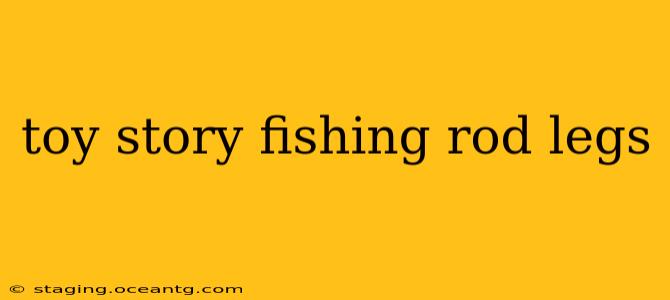Toy Story's enduring appeal lies not just in its heartwarming characters and adventurous storylines, but also in its boundless potential for imaginative play and creative expansion. One such example is the surprisingly popular trend of using fishing rods as legs for toys, particularly those from the Toy Story universe. This seemingly simple modification opens up a world of possibilities, sparking creativity and prompting questions about the nature of play and the inherent adaptability of toys themselves.
Why Use Fishing Rods as Toy Legs?
The use of fishing rods as toy legs isn't just a random internet fad; it's a clever workaround to several problems toy owners face. The rods provide:
-
Height and Stability: Many action figures, especially those of iconic characters like Woody and Buzz Lightyear, are relatively small and can be prone to tipping over. The fishing rod legs provide considerable height, improving stability and making them easier to pose and display.
-
Posability and Articulation: Fishing rods, particularly those with telescopic sections, offer a surprising degree of articulation. This allows for dynamic posing, capturing action sequences and mimicking scenes from the movies. You can adjust the length and angle of the legs to achieve a variety of positions.
-
Aesthetic Appeal: While unconventional, the fishing rod legs can add a unique aesthetic. It can be seen as a playful and slightly quirky modification, adding a touch of humour and originality to the display.
-
Accessibility and Affordability: Fishing rods are relatively inexpensive and readily available. This makes it an accessible modification for many enthusiasts.
What Kind of Fishing Rods Work Best?
The best fishing rods for this purpose will depend on the size of the toy and the desired effect. Generally, lightweight and flexible rods are preferred to avoid overwhelming the toy. Telescopic rods are highly advantageous due to their adjustable length and compact storage.
How to Attach Fishing Rods to Toy Legs?
There are several methods for attaching fishing rods to toy legs, each with its own pros and cons:
-
Glue: Strong adhesives like epoxy or super glue can provide a permanent bond. However, this requires care to avoid damaging the toy and achieving a clean, invisible joint.
-
Small Screws and Nuts: This method allows for disassembly, but requires drilling small holes in the toy, which might be undesirable for some collectors.
-
Clamps or Clips: Smaller clamps or specialized miniature clips designed for model building can provide a secure and easily removable connection.
Are there any Disadvantages?
While using fishing rods as legs offers many advantages, some potential drawbacks exist:
-
Durability: The connection points can be vulnerable, especially with less robust attachment methods. Rough handling or accidental impacts can damage the connection.
-
Aesthetics: While some find the modification appealing, others might find it detracts from the original aesthetic of the toy.
What Other Toys Can This Mod Be Applied To?
This modification is not limited to Toy Story characters. It can be adapted to a wide variety of action figures and collectible toys of different sizes and scales, giving them a unique look and improved stability.
Where Can I Find More Information on This Mod?
Various online communities, forums, and social media groups dedicated to toy customization and modding offer extensive resources, tutorials, and examples of this and other creative toy modifications. Searching for terms like "toy fishing rod legs," "action figure modding," or "custom toy stands" can yield a wealth of information and inspiration.
This unique modification transforms the humble fishing rod into an unexpected tool for imaginative play and custom toy display. It highlights the adaptability of toys and the enduring creativity of their enthusiasts.
